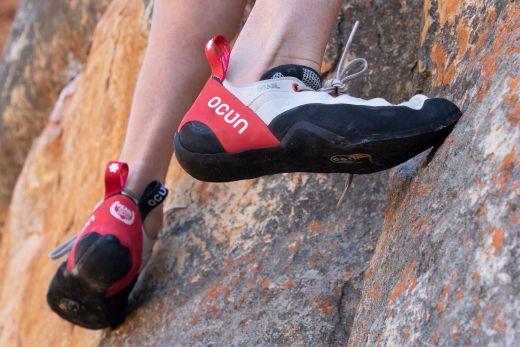Magic, voodoo, or alien technology! If you had never seen a climber smear their way up a featureless slab before, the sight could leave you with the impression that there’s something more than the simple laws of physics at work – such is the marvel that is modern climbing rubber. But, by now you’re well acquainted with sticky rubber and what it can do, so maybe the stuff doesn’t seem as amazing as it once did. Fair enough, but that doesn’t mean that climbing shoe rubber isn’t worth a closer look. If you are pushing grades and looking for advantages (even small ones) wherever they may be found, reconsidering your choice of footwear and sticky rubber might reveal new opportunities for improved performance – the kind that can make all the difference when the only thing between a send and a fall is a tenuous smear.
In this article, we will do just that and look at how the properties of sticky rubber translate to performance on different types of rock. That you can make an even more informed decision when it’s time to choose another pair of rock shoes.
Edging power vs stickiness
Pure stickiness is a result of a compound’s softness, and herein lies a problem. Softer rubber doesn’t hold an edge well, and the average climbing shoe has to be as good at edging as it is at smearing. Having taken this into account, shoe manufacturers fit most of their rock shoes with rubber of moderate softness. For 95% of climbers, these will be more than sticky enough, and in some situations, knowledgeable climbers will even sacrifice some of that stickiness for increased edging power.
Durability
The other reason you might want harder and slightly less sticky rubber is that you’re a beginner and are going to punish your shoes with sloppy footwork. Softer rubber is generally less durable, and a pair of soft, wafer thin $150 high performance shoes won’t last three sessions on your feet. If you fall into this category, your money would be better spent on shoes with stiffer more durable rubber. The same goes for climbers who average a few thousand feet in a single session.
Brands and compounds
The difference in quality between these brands is almost negligible, but there is a distinguishable difference in the stickiness, firmness and durability of their different compounds. Knowing how these will affect a compound’s performance can help you make a more informed decision when you next look at a shoe's specs.

Vibram is the only brand of rubber that is developed specifically for use in the manufacturing of shoes made by other shoe brands – It does not actually make its own rock shoes. That said, it is the most popular brand of rubber out there and can be found on shoes produced by La Sportiva, Scarpa, Tenaya, Ocun, and Red Chilli among others.
XS Grip
Vibram’s XS Grip has been around for over a decade and is still by far the most widely used rubber compound out there. Offering a good balance of stickiness and firmness, this compound is designed to perform well on any rock surface, making it a solid all rounder.
| Stickiness | ★★★★ |
| Edging power | ★★★★ |
| Durability | ★★★ |
| Tenaya shoes | Ocun shoes | Red Chili shoes |
| Aqua+ | Diamond | Fusion (all versions) |
| Iati | Ozone | Mystix Sensor |
| Inti | Ozone HV | Voltage 2 |
| Masai | Sigma | Voltage Lace |
| Mastia | Voltage LV | |
| Mundaka | ||
| Oasi | ||
| RA | ||
| Tarifa | ||
| Tatanka | ||
| Indalo |
XS Grip2
This updated version of Vibram’s favorite compound is a bit stickier than the original, making the rubber of choice for more performance-focussed shoes. You’ll find it on half of all shoes in the La Sportiva range and on mid to high-end shoes in Scarpa’s range.
| Stickiness | ★★★★★ |
| Edging power | ★★★★ |
| Durability | ★★★ |
| La Sportiva shoes | Scarpa shoes |
| Cobra (all versions) | Arpia |
| Python | Booster |
| Futura | Chimera |
| Genius | Drago (all versions) |
| Kataki | Furia (all versions) |
| Katana (all versions) | Instinct (women’s versions) |
| Kubo | Mago |
| Mantra | Quantix |
| Otaki | Vapor (women’s VC) |
| Skwarma | |
| Solution (all versions) | |
| Solution Comp | |
| Testarossa | |
| Theory |
XS Edge
Vibram’s firmest rubber offers unparalleled edging power and is more durable than most other compounds. It’s not quite as sensitive as the grip series, but it will keep its shape mile after mile of hard climbing, making it an excellent choice for technical shoes.
| Stickiness | ★★★ |
| Edging power | ★★★★★ |
| Durability | ★★★★ |
| La Sportiva shoes | Scarpa shoes |
| Miura (all versions) | Boostic |
| Katana (all versions) | Force V |
| Mythos (all versions) | Generator Mid |
| Otaki | Instinct (men’s versions) |
| TC Pro | Maestro Mid |
| Quantic | |
| Vapor (men’s lace and VC, women’s lace) |

Ocun is the most recent brand to develop its own rubber compounds and now uses its Cat rubber on most of its shoes.
Cat 1.1
Cat 1.1 is the stiffer of Ocun’s two compounds and was originally designed to prioritize edging ability. But it is now only used on Ocun’s entry level shoe, largely because it is more durable than Cat 1.5
| Stickiness | ★★★ |
| Edging power | ★★★★★ |
| Durability | ★★★★ |
| Ocun shoes |
| Striker LU |
Cat 1.5
Cat 1.5 is softer than Cat 1.5 and is designed to offer a balance of firmness and stickiness comparable to Vibram XS Grip, which it has largely replaced in the Ocun range. There’s a good chance it will eventually replace XS Grip in the remaining Vibram-soled Ocun shoes.
| Stickiness | ★★★★ |
| Edging power | ★★★★ |
| Durability | ★★★ |
| Ocun shoes |
| Fury |
| Bullit |
| Havoc |
| Jett Crack |
| Pearl |
| Iris |

Like Ocun, Evolv developed softer and harder compounds but then decided that they really only needed one.
SAS
Originally develop as Evolv’s general purpose compound, Trax SAS is now used on almost all Evolv rock shoes. In terms of properties, it seems to be a little softer than its Vibram equivalent, XS Grip, which could equate to slightly less edging power, but you’re probably not going to be able to tell the difference without a durometer.
| Stickiness | ★★★★ |
| Edging power | ★★★ |
| Durability | ★★★ |
| Evolv shoes |
| Zenist (all versions) |
| Shaman (all versions) |
| Geshido (all versions) |
| Defy (all versions) |
| Elektra (all versions) |
| V6 |
| Phantom |
| Kronos |
| Yosemite Bum |
XE
Evolv used to produce a second compound called Trax XE. This was stiffer than Trax SAS and comparable to Vibram XS Edge. Evolv might find a reason to bring it back, but right now, it’s not found on any of their shoes.
| Stickiness | ★★★ |
| Edging power | ★★★★ |
| Durability | ★★★★ |

In much the same vein as Vibram and Evolv, Boreal has also produced two compounds with different degrees of softness and edging power.
Zenith Ultra
Boreal’s stickiest rubber fulfills a similar role to Vibram’s XS Grip2 – it allows climbers to make the most of marginal smears, even on steep terrain. As with other very soft and sticky compounds, this does mean compromising on durability.
| Stickiness | ★★★★★ |
| Edging power | ★★★ |
| Durability | ★★ |
| Boreal shoes |
| Synergy |
| Satori (all versions) |
| Indo (all versions) |
| Ninja |
Zenith Pro
Zenith pro is Boreal’s most commonly used rubber. It is most similar to Stealth C4 or Trax SAS though some users have reported that Boreal’s rubber to be a little more slippy until it has been slightly worn in. Don’t let this detract you. After just one session, it’s as sticky as comparable compounds.
| Stickiness | ★★★★ |
| Edging power | ★★★★ |
| Durability | ★★★ |
| Boreal shoes |
| Dharma (all versions) |
| Lynx (all versions) |
| Crux (all versions) |
| Mutant |
| Ace |
| Ballet |
Zenith Quattro
Like other brands, Boreal uses their stiffer rubber on their entry level shoes and the shoes designed for powerful edging and crack climbing. Like shoes with Zenith Pro, shoes soled with Zenith Quattro might need a session to get them performing optimally.
| Stickiness | ★★★ |
| Edging power | ★★★★★ |
| Durability | ★★★★ |
| Boreal shoes |
| Silex (all versions) |
| Beta (all versions) |
| Joker (all versions) |
| Alpha (all versions) |
Five Ten Stealth
Five Ten was once a big name in climbing. Unfortunately, it has since been taken by Adidas, which discontinued many models as well as two of the original three Stealth compounds.

C4
This compound was a favorite until Adidas decided to change the recipe. The general consensus is the new C4 compound is actually worse – just another reason to not buy a new pair of Five Tens. This is all very sad since Five Ten used to make great shoes.
| Stickiness | ★★★ |
| Edging power | ★★★ |
| Durability | ★★★ |
Learn more
If you’re shopping around for a new pair of climbing shoes, you probably already know there’s a lot more to shoe choice than rubber compound. Features, last type, and intended use all need consideration during this important decision. But with some many factors to take into account, how do you know what to look at first? Lucky for you, I’ve published a rock shoe gear guide that can help you choose your next pair of climbing shoes.
